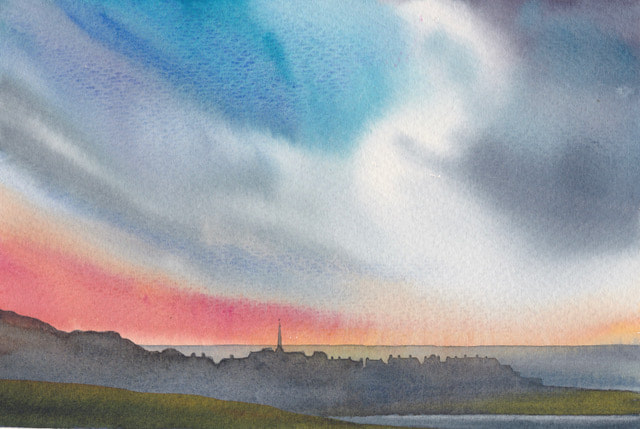Alnmouth by Ian Scott Massie
Original Watercolour
12" x 16" Mounted size - 7.5" x 10.5" Image size
Available: unframed @ £340
To shop, please click here
12" x 16" Mounted size - 7.5" x 10.5" Image size
Available: unframed @ £340
To shop, please click here
ALNMOUTH
Alnmouth’s history is intimately connected to the sea and it’s a place where I’ve had some very happy holidays. One of the town’s earliest mentions is by its ancient name of Twyford (two fords) when Bede recounts the Synod of 684 at which Cuthbert was elected Bishop of Lindisfarne, suggesting that Alnmouth was a place of some importance. And although the town faced its downs: the raids of the Scots, the Black Death, and its ups: the growing trade in shipping corn and major export links, it is the fate of Church Hill which came to dictate Alnmouth’s future.
The winding river Aln was always difficult for shipping. Shifting sands and silted channels had to be continually monitored to keep things moving. But on Christmas Day 1806, during a tremendous storm, came the blow which changed the town forever. The twisting course of the river was suddenly altered by the weight of water pouring towards the sea. The storm burst the river’s banks and forced it into a new channel. Now, the town lay on one side and the church on the other. Worse, the storm then proceeded to destroy the church and the site on which its stood.
As St Stephen’s Day dawned, Alnmouth looked very different and, although the storm didn’t finish the harbour’s life, it marked the beginning of its end. In 1847 the railway arrived and, with it, a way of moving goods that might once have gone by sea. In 1896 the Joanna, a brigantine carrying timber from Scandinavia, capsized in Alnmouth’s shallow harbour. As a result of this, shipping owners struggled to get insurance to cover vessels entering the port.
By this time, however, the first substantial numbers of tourists were arriving - mostly by train. Once again the pubs and shops were doing good business and things were looking up. People came to play a round on the country’s second oldest golf course and stayed to explore the prolifically haunted Schooner Inn. And today Alnmouth’s peaceful air gives little to suggest its troubled past.
The winding river Aln was always difficult for shipping. Shifting sands and silted channels had to be continually monitored to keep things moving. But on Christmas Day 1806, during a tremendous storm, came the blow which changed the town forever. The twisting course of the river was suddenly altered by the weight of water pouring towards the sea. The storm burst the river’s banks and forced it into a new channel. Now, the town lay on one side and the church on the other. Worse, the storm then proceeded to destroy the church and the site on which its stood.
As St Stephen’s Day dawned, Alnmouth looked very different and, although the storm didn’t finish the harbour’s life, it marked the beginning of its end. In 1847 the railway arrived and, with it, a way of moving goods that might once have gone by sea. In 1896 the Joanna, a brigantine carrying timber from Scandinavia, capsized in Alnmouth’s shallow harbour. As a result of this, shipping owners struggled to get insurance to cover vessels entering the port.
By this time, however, the first substantial numbers of tourists were arriving - mostly by train. Once again the pubs and shops were doing good business and things were looking up. People came to play a round on the country’s second oldest golf course and stayed to explore the prolifically haunted Schooner Inn. And today Alnmouth’s peaceful air gives little to suggest its troubled past.





